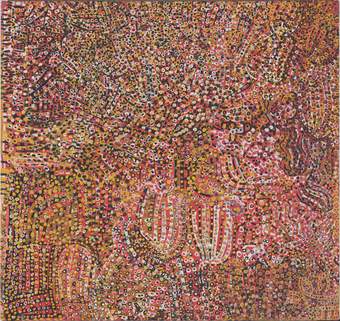
Emily Kam Kngwarray, Ntang Dreaming 1989 National Gallery of Australia, Canberra. © Emily Kam Kngwarray/Copyright Agency. Licensed by DACS 2025
This summer, É«¿Ø´«Ã½ will stage Europe’s first major solo exhibition dedicated to one of the most extraordinary figures in international contemporary art, Emily Kam Kngwarray (c.1914-1996). A senior Anmatyerr woman from the Sandover region in the Northern Territory of Australia, Kngwarray translated her ceremonial and spiritual engagement with her ancestral Country, Alhalker, into vivid batik textiles and monumental acrylic paintings on canvas. Taking up painting in her 70s and devoting her final years to creating a large body of art, Kngwarray forged a path for Aboriginal and Torres Strait Islander artists, women artists and Australian artists, and continues to entice audiences around the world three decades after her passing. Organised in collaboration with the National Gallery of Australia, this extensive survey will bring together over 70 works from across her short but extraordinary career. Showing many works outside Australia for the first time, the exhibition will offer European audiences a once in a lifetime chance to experience Kngwarray’s powerful paintings and vibrant legacy.
Kngwarray began experimenting with new art media at Utopia Station in the 1970s. After learning the technique of making batik, in the late 1980s she transitioned to painting in acrylic on canvas. Her practice was shaped by her intimate knowledge of her Country and by her role in women’s ceremonial traditions of ‘awely’, which encompass song, dance and the painting of bodies with ground ochres. She sat on the ground when she painted, much in the same way she would sit to prepare food, dig yams from the earth, tell stories by drawing on the sand or ‘paint up’ for awely ceremonies. Her deeply personal approach to painting was developed in isolation from the European and North American artistic practices of her time. This exhibition will present Kngwarray’s work through the lens of her own world, showcasing her as a matriarch, sister, friend, storyteller, singer, visual artist, and custodian of Country.
Encapsulating the ecology of her homeland, Kngwarray’s work features motifs derived from native plants, animals and natural forms. The exhibition will begin by presenting one of her earliest batiks on cotton from 1977, alongside Emu woman 1988, Kngwarray’s first ever work on canvas that saw her receive widespread national attention. Kngwarray regularly depicted the emu (ankerr), reflecting the animal’s significance to Aboriginal Peoples, as well as the pencil yam (anwerlarr) and its edible underground seedpods (kam), after which she is named. These works trace the evolution of the artist’s visual language, grounded in her detailed knowledge of the desert ecosystems of Alhalker and neighbouring Countries.
Important works from the early phase of Kngwarray’s painting career will be presented alongside a display of batiks on silk and cotton that hang from floor to ceiling and immerse visitors in the artist’s vivid evocations of her Country. Painted in earthy hues, Ntang Dreaming 1989 depicts the edible seeds of the woollybutt grass (alyatywereng), while Ankerr (emu) 1989 maps a path of emu footprints travelling between water sources. These major works on loan from public and private collections will be joined by three acrylic paintings acquired for °Õ²¹³Ù±ð’s collection in 2019 - Untitled (Alhalker) 1989, Ntang 1990, Untitled 1990 – as well as the three-metre Kam 1991, showing how Kngwarray began scaling up her established style and employing brighter colours.
At the heart of the exhibition will be The Alhalker suite 1993, one of Kngwarray’s most ambitious works. Offering a vibrant portrait of Alhalker Country across 22 canvases, the series pays homage to the Altyerr, the eternal life force that created the land and its myriad living forms and defined the social and cultural practices of people. Produced at the height of Kngwarray’s painting career, the work reveals her broadened colour spectrum and techniques, with bright pastel pinks and blues evoking the wildflowers which carpet the landscape after rainfall, and collections of merging dots representing the rockfaces and grasslands of Alhalker. Kngwarray did not impose any limitations for the configuration of the panels, so a new way of seeing her land is presented each time the work is displayed- an ongoing reminder that the stories and places she painted are very much alive.
In her final years, Kngwarray made an abrupt stylistic change, creating a suite of works comprising bold parallel monochrome lines in her familiar palette of reds and yellows, painted on white paper or canvas. É«¿Ø´«Ã½ will present Untitled (awely) 1994, a six-panel work originally shown as the centerpiece of the Australian Pavilion at the 1997 Venice Biennale. The evident tactile quality with which Kngwarray applied the paint evokes the gesture and intimacy of painting on the body for awely ceremonies. Moving away from lines and dots during this late period, Kngwarray developed gestural paintings with fluid brushstrokes that burst with energy. Closing the exhibition, Yam awely 1995 with its intricately painted twists of white, yellow and red intertwined with linear markings of grasses, yams, roots and tracks, signifies the timeless connection between Kngwarray and her Country.
